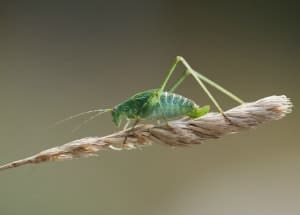These nighttime musicians can constitute a great menace to many crops, including vegetables, tobacco, beans, corn, wheat, and others. These plants are perfect food sources for crickets. Crickets eat the leaves or bite the stem right at the root, providing damage and causing the death of the greenery.
The infestation of crickets can be a severe threat to your harvest or your property, so it is better to learn how to get rid of crickets. Use this article as your complete guide on finding the best means for cricket control outside and inside.
How to Deter Crickets & Deal with Them: Guides & Tips
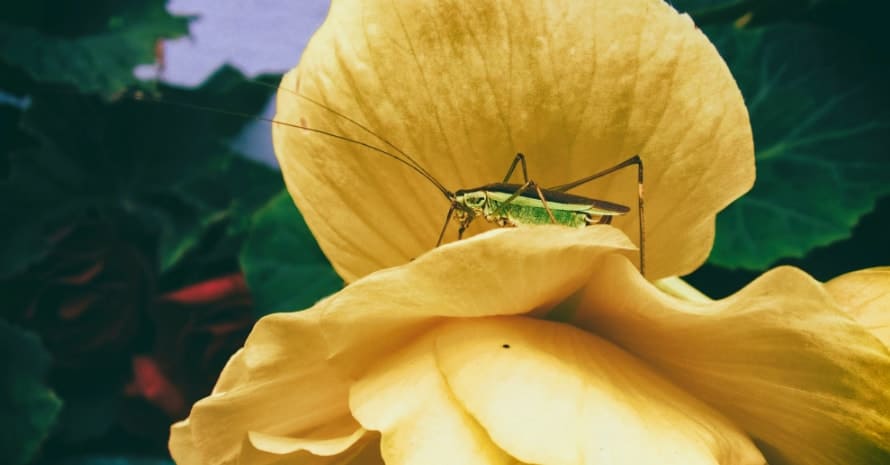
To know what keeps crickets away, first, you have to know what attracts a cricket to your house.
What does a cricket look like?
Crickets are small insects. The adult individuals reach only 16 to 26mm in length. The color of their body is usually grayish-yellow, but they can also be different shades of brown, with yellow stains or spots of indefinite shape. Crickets feed on smaller insects and plants.
They usually “sing” in the dark and sleep in the daytime. Crickets prefer to settle in meadows, fields, farms, industrial buildings, basements, and country houses. The optimum temperature for these insects is 30-35 degrees, and at 20 degrees or less, they fall into an apathetic state, stop eating, and multiplying.
The head of cricket is shaped like an oblate egg. There are also three dark arcuate stripes on its head. The eyes of cricket have a complex faceted structure and are located on the sides of its head. Its mouth has a large mustache, and sometimes it’s larger than the insect’s body. The cricket mustache serves a practical purpose; it is responsible for the sense of touch.
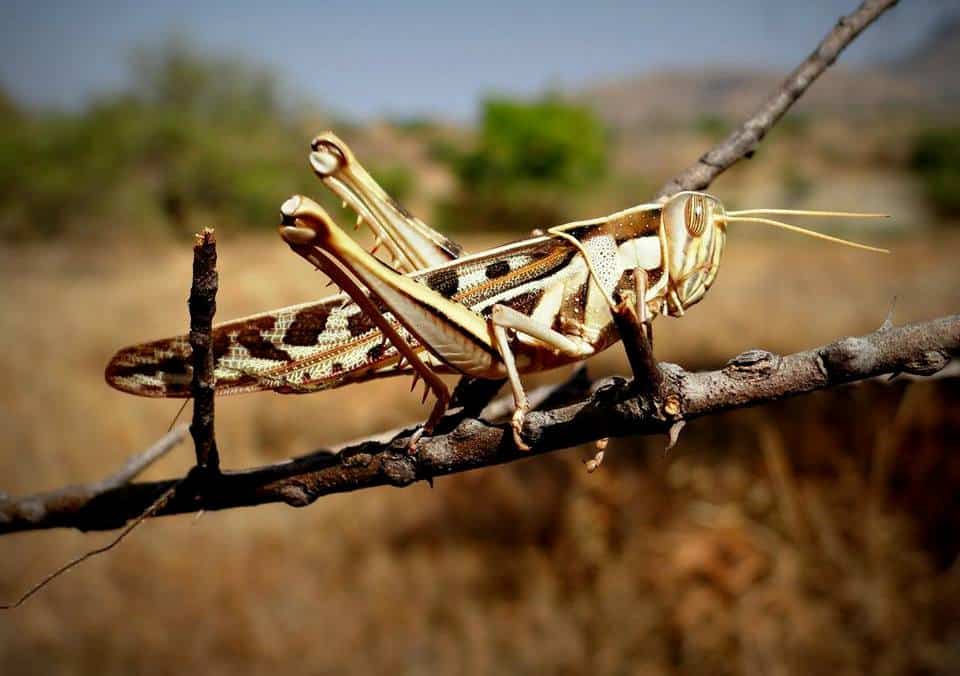
What attracts crickets in the house?
Like all other insects that can appear in your home, crickets are attracted by heat and food. In the summer, crickets mainly inhabit green areas near residential buildings, but with the onset of cold weather, they begin to move into basements, and then into heated apartments, as well as into houses.
The perfect environment for their life is an abundance of food, acceptable humidity, and temperature. In addition to these conditions, crickets are attracted by unsanitary ones (like cockroaches, flies, and ants). Before deciding how to deal with insects, it is highly recommended to clean up your residence first.
Light
Although crickets sleep during the day, having found a secluded place, they become active at night, hunt for food, fight with enemies who have come to their territory. Also, bright light attracts melodious insects to people’s homes.

Garbage smell
Leftovers of food in a warm room quickly begin to rot. Crickets, having felt a specific aroma, go to the place where the smell comes from since they do not mind eating spoiled food.
Open windows
Crickets easily crawl into microscopic cracks. Open windows and doors attract these curious insects.
Cricket damage
The bad news is that crickets are omnivorous. Food leftovers, crumbs, and especially trash bins with decaying remains are what attract them into your house. They also eat other invertebrates and practice insect cannibalism. Sometimes, crickets can spoil food and even things in the apartment, as well as moths.
Therefore, the owners have to decide how to remove the crickets that have settled in the house. Domestic crickets do not cause significant damage to people and their homes, but it is better to get rid of the cricket infestation since these insects with their “songs” simply will bring you insomnia.
Signs of a cricket infestation
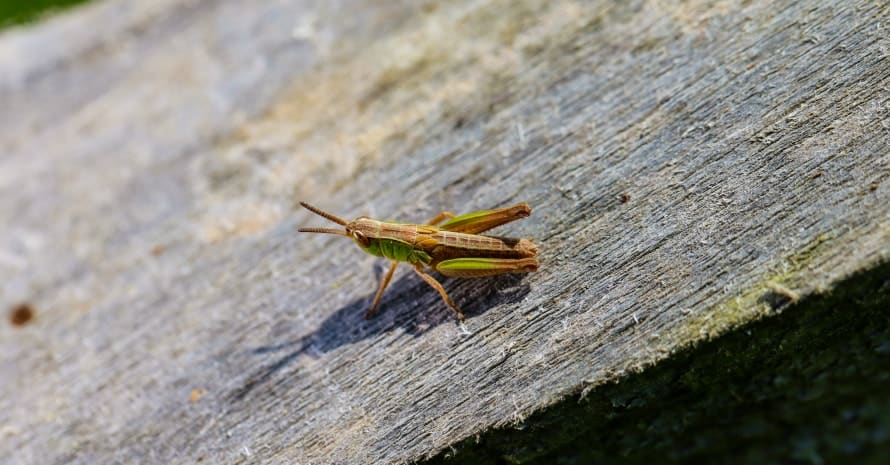
If cricket is wound up in a dwelling, it will be obvious for all of the residents. The monotonous trills that distract your sleep at night invariably generate a desire to get rid of this unwelcome “guest” quickly.
[su_note note_color=”#e5e2d4″]Related post: How to Get Rid of Spider Crickets [/su_note]
How to Get Rid of Crickets
First, you need to get rid of the dampness by reducing the level of humidity in all rooms. Pay special attention to the one where crickets may live (usually the bathroom). When conditions change, insects will immediately rush in search of more comfortable places. If crickets can’t escape the dry room, death is unavoidable.
Many people try to catch this insect and take it out of the house, but this is not as easy as it may seem. The thing is that crickets do not allow anyone closer than 10 ft. This happens due to the fact that cricket has an impeccable hearing, and it senses any vibrations in the air.
Therefore, catching a cricket without extra means and tools is probably impossible unless you can move like a real ninja.
While crickets can help fight moths, they also distract residents from sleeping at night. That’s why it is better to apply measures to keep crickets out of the house.
Sticky traps
Using sticky traps is the best way to kill crickets. For successful cricket removal, place them in areas where these creatures prefer to “give concerts”. To make the fight more effective, it is better to set several traps. Although the adhesive tape or trap is inexpensive, the effect is significant.
Close all water sources
These insects usually settle in the bath or kitchen near the taps because they love moisture. In a dry room, the bugs feel uncomfortable. With a prolonged lack of access to water, they die.
[su_note note_color=”#e5e2d4″]Related post: How to Get Rid of Earwigs [/su_note]
Folk remedies
You can not fight crickets, but start expelling them using DIY remedies prepared on the basis of various plants. For example:
Wormwood decoction

Take 2 tablespoons of crushed leaves and stems of the plant and pour 0.5 gallons of water. Boil the mixture for about 5 minutes and then infuse for about 2 hours. Then, you have to filter it and pour the solution into a spray bottle. Spray the areas of the baseboards, floors, walls, window sills, platbands, window frames, where the crickets are most likely to show up.
Pyrethrum powder
This product is absolutely safe for humans and pets. The pyrethrum is a specific type of chamomile that is used to fight various insects. Crickets are no exception, and they also do not tolerate this scent. The powder should be simply sprinkled in places where crickets prefer to hunt.
Chemicals
When there are too many insects, and folk methods of fighting do not give the desired result, it’s time to use more severe products. Chemicals can be dangerous for kids and pets, but they provide 100% result of killing crickets in a house. Repeated processing after a week helps to get rid of the individuals that emerged from eggs.
Top 3 Best Cricket Treatments to Keep Crickets Out of House
After you learned several essential rules for cricket removal, it’s time to choose the best cricket control product.
1. Catchmaster Cricket XL – The Best Cricket Trap
[amazon box=”B07SHHS33Z” template=”vertical” tracking_id=”how-to-get-rid-of-crickets-20″ button_text=”Check price on Amazon”]
Specifications:
- Material: Glue
- Number of Pieces: 6
- Item Weight: 7 ounces
- Product Dimensions LxWxH: 0.47 x 5.31 x 1 inches
- Target Species: Cricket, Scorpion, Spider
The Catchmaster glue traps provide the best effect for catching crickets, cockroaches, and other running insects. Thanks to the special formulation of the glue, the glue trap remains effective for up to 3 months. The Catchmaster can be used in any room. It’s safe for children, pets, and allergy sufferers. The trap does not contain chemical insecticides, and it’s the most effective in dry rooms with low humidity.
Remove the trap from the packaging and place it in the place where insects are often found, for example: near the plumbing and sewer pipes, behind cupboards, in corners, etc. If there are no insects in the trap for several days, you should move it to another place. The trap is not reusable, so you have to throw it away right after it gave you the results.
| Pros: | Cons: |
|
|
2. BASF Cy-Kick CS Pest Control Insecticide – The Best Cricket Insecticide
[amazon box=”B004FBOTFM” template=”vertical” tracking_id=”how-to-get-rid-of-crickets-20″ button_text=”Check price on Amazon” button_detail=”https://shareasale.com/r.cfm?b=410159&u=2583381&m=43235&urllink=www%2Edomyown%2Ecom%2Fcykick%2Dcs%2Dp%2D250%2Ehtml&afftrack=how%20to%20get%20rid%20of%20crickets” button_detail_text=”Check price on DoMyOwn”]
Specifications:
- Active Ingredient: Cyfluthrin 6%
- Item Form: Spray
- Item Weight: 1.21 Pounds
- Product Dimensions LxWxH: 4.75 x 7 x 1.85 inches
- Target Species: Ants, Bed Bugs, Boxelder Bugs, Carpenter Ants, Carpenter Bees, Carpet Beetles, Centipedes, Clover Mites, Cluster Flies, Cockroaches, Crickets, Earwigs, Fire Ants, Fleas, Flies, Grasshoppers, Hornets, Millipedes, Mosquitoes, Scorpions, Silverfish, Spiders, Springtails, Termites, Ticks, Yellow Jackets and others
BASF Pest Control Insecticide is one of the best ultimate insect repellers that work both inside and outside. Due to the high consistency and uniform redistribution of the active substance on the surface, the crickets and other pests will have no chances to make it out alive.
Despite its dangerous components, the Cy-Kick insecticide is safe for pets, so you don’t have to worry when applying it on the territory of your residence.
However, the manufacturer recommends using special rubber gloves and a face mask to protect the skin from chemicals. To prepare a solution, mix the stated amount of insecticide with water and spray it on the needed areas. Don’t forget to clean the rooms you’re going to process first. A clean and dry surface will make it easier for the insecticide to provide the best result. The BASF Insecticide will deal with a cricket infestation in less than 48 hours.
| Pros: | Cons: |
|
|
3. Delta Dust Multi Use Pest Control Insecticide – The Best Cricket Killer Dust
[amazon box=”B002Y6B4A8″ template=”vertical” tracking_id=”how-to-get-rid-of-crickets-20″ button_text=”Check price on Amazon” button_detail=”https://shareasale.com/r.cfm?b=410159&u=2583381&m=43235&urllink=www%2Edomyown%2Ecom%2Fdelta%2Ddust%2Dinsecticide%2Dp%2D44%2Ehtml&afftrack=how%20to%20get%20rid%20of%20crickets” button_detail_text=”Check price on DoMyOwn”]
Specifications:
- Active Ingredient: Deltamethrin 0.05%
- Yield: 1 lb. of Delta Dust covers about 2,000 sq.ft.
- Item Weight: 1 pounds
- Product Dimensions LxWxH: 3.8 x 1.9 x 9.63 inches
- Target Species: Ants, Bed Bugs, Boxelder Bugs, Cockroaches, Crickets, Fleas, Firebrats, Silverfish, Termites, Carpenter Ants, Carpenter Bees, Centipedes, Ground Bettles, Millipedes, Scorpions, Spiders, Sowbugs, Wasps, Bees, Webbing, Clothes Moths, Carpet Beetles, Pantry Pest, Plant Pest, Slugs, and Ticks
The Delta Dust Pest Control Insecticide is designed to kill all types of crickets, cockroaches, and other crawling insects in your apartment. The powder works as a bait that lures an insect and kills it immediately. This is one of the most wide-spread products for processing residences, offices, industrial premises, and other places where insects often gather.
The Delta Dust is 100% waterproof, so if you spot the crickets in your bathroom, you can use it even in the shower. One application of the insecticide works up to eight months and continues to kill the insects, preventing their multiplying. Use it with a hand or power duster.
| Pros: | Cons: |
|
|
How to prevent crickets
These easy and affordable options can help to keep your home safe from many insects that may settle in the private house or apartment. Here’s what you have to do to get rid of crickets outside and inside:
- Set mosquito nets on the windows;
- Fill up any crevices where insects can hide;
- Make sure that you empty the trash can regularly, and there are no food leftovers on the dining table;
- Check if your plumbing works properly, and there is no excess moisture;
- Monitor the condition of basements and attics;
Note: this works especially for those who live on the ground floors. First of all, crickets in basement appear on the lower floors through the cracks. These entrances can be located near the various communications (cold and hot water, sewage, gas, electricity).
- Reconsider the lighting in the yard and do not use high power lamps;
- Install strong mesh on ventilation systems;
- Place the compost heaps as far from home as possible.
As it gets dark, don’t forget to close your blinds and curtains. Remember that bright light always attracts insects and acts as an invitation sign, and crickets are no exception. If you follow these fairly simple rules, you can sleep peacefully without fearing that “performances” will disturb your sleep.
If a cricket appeared in a dwelling, it is better to get rid of it immediately. Otherwise, after a while, it will no longer be alone if the conditions are favorable.
At the same time, you need to think about what attracted these insects, but for this, you need to know where the night “musicians” live and what they eat. If you do not solve this issue in time, one cricket can turn into a whole infestation.
[su_note note_color=”#e5e2d4″]Related post: How to Get Rid of Asian Lady Beetles [/su_note]
FAQ
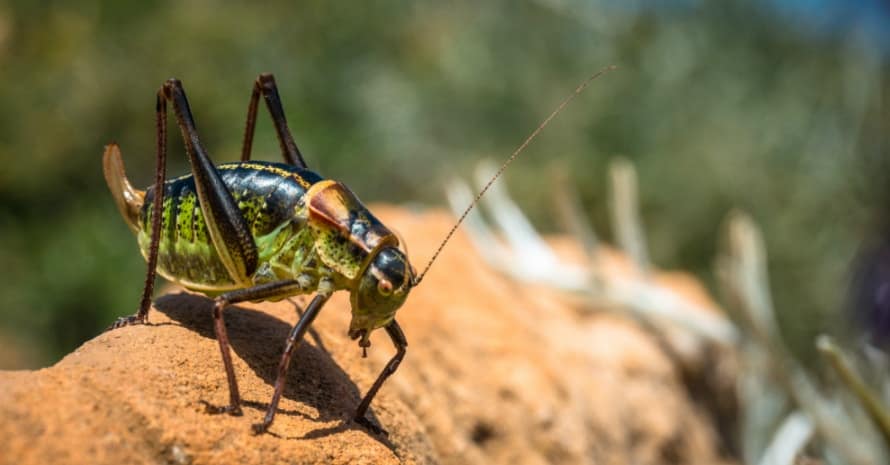
You have to be fully equipped with the knowledge and proper weapons to fight your noisy enemy. So, this section will help you to find the answers on questions like what repels crickets and others.
What does cricket eat?
In nature, male and female crickets feed on plants and greenery. In human dwellings, they eat homemade food, especially wet and liquid. House crickets also feed on small invertebrates and soft cadaveric tissues. They also practice cannibalism when adult insects eat clutches and juveniles.
Where do crickets come from?
Crickets mostly live outside your house, but in cold seasons they can settle inside. For example, finding crickets in the basement in winter shouldn’t surprise you, since they come for a wet and warm place. So, you have to apply all possible methods to keep crickets out of the house.
Do crickets eat clothes?
Crickets are generally not considered as pests, but like cockroaches, they love stained and odorless clothing, food and drink stains, and laundry starch. A cricket eats the stain and can damage the fiber texture. If you find holes when clothes are washed or removed from the closet, it doesn’t mean that you have crickets.
But if you heard their sound at night and woke up finding a damaged piece of clothing, it’s better to deter crickets and start processing your house with cricket removal treatments.
[su_note note_color=”#e5e2d4″]Related post: How to Get Rid of Pill Bugs [/su_note]
Does vinegar kill crickets?
The essence of vinegar for fighting bed bugs with a high concentration of acid is capable of killing various insects. It penetrates through the chitinous cover, clogs the spiracles, and destroys away the insides of the insect. However, to achieve such an effect, you have to pour the essence on an insect by yourself. It is better to do it with rubber gloves and a face mask to stay away from the concentration of dangerous acid.
Where do crickets nest?
Crickets breed throughout the year, but their peak of mating activity occurs in the summer. A fertilized female cricket prepares holes in the ground where it lays its eggs. During one gestation, a female cricket can lay from 40 to 179 eggs.
Further, from one to two months (depending on the temperature and on the environment in general), larvae begin to grow. The larva in its appearance resembles an adult cricket, but in order to become one, it has to go through 10 molts, which take place over 7 weeks. After the last molt, the larva produces a typical sexually mature cricket.

The Best Way to Deal with Crickets in a House
By multiplying and increasing the settlement, crickets spoil clothing, paper, furniture, and even wall surfaces. You can get rid of them using chemicals, traps, or by removing. The choice of the method depends on the number of crickets in your house or your desire. Luckily, you already know the main reasons why crickets can appear in your residence and how to keep crickets away from it.
Make a successful purchase and get the best results from applying it. I highly recommend choosing one of the treatments stated above as they show the amazing effects. Whether you settle your opinion on the glue trap, insecticide, or powder – don’t forget to be careful when applying the chosen way of cricket removal. The question of how to kill crickets has at least three answers, and you can find a proper option using this guide.
Anyway, if there are any unanswered questions left — use the comments section below, and I will manage an answer as soon as I can. Also, I would appreciate it if you could help me by sharing your thoughts. Should insecticides be allowed for at-home usage? Which safety precautions should be noted when using an insecticide in a house with kids and pets? Hope to hear from you soon!
References:
- House Cricket (University of Florida):
http://entnemdept.ufl.edu/creatures/misc/crickets/adomest.html - Pesticides to Control Bed Bugs (U.S. Environmental Protection Agency):
https://www.epa.gov/bedbugs/pesticides-control-bed-bugs - Vinegar: Medicinal Uses and Antiglycemic Effect (U.S. National Library of Medicine National Institutes of Health):
https://www.ncbi.nlm.nih.gov/pmc/articles/PMC1785201/

